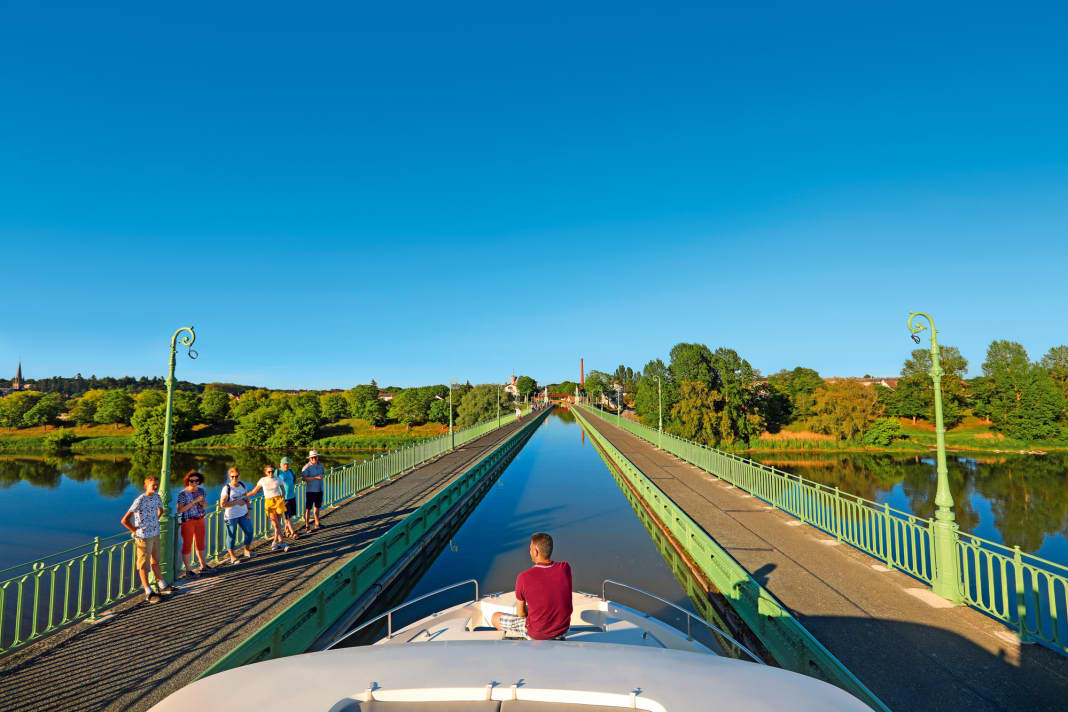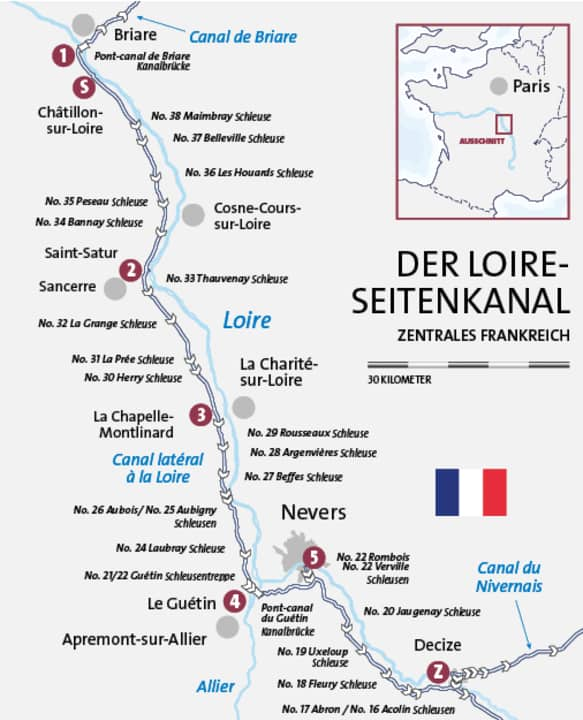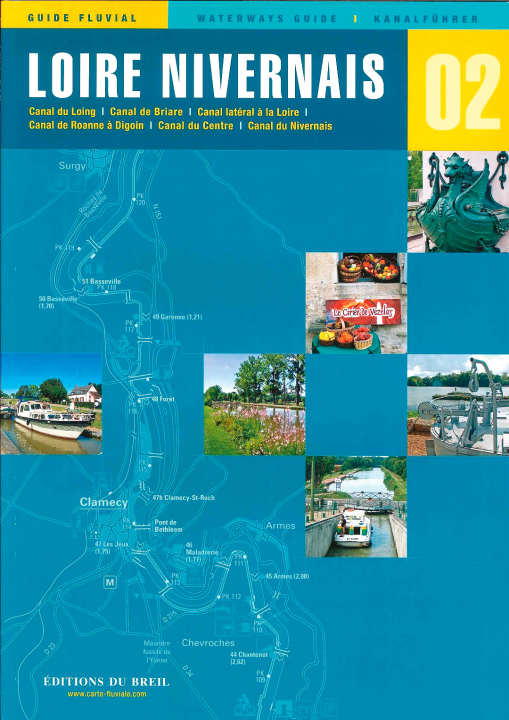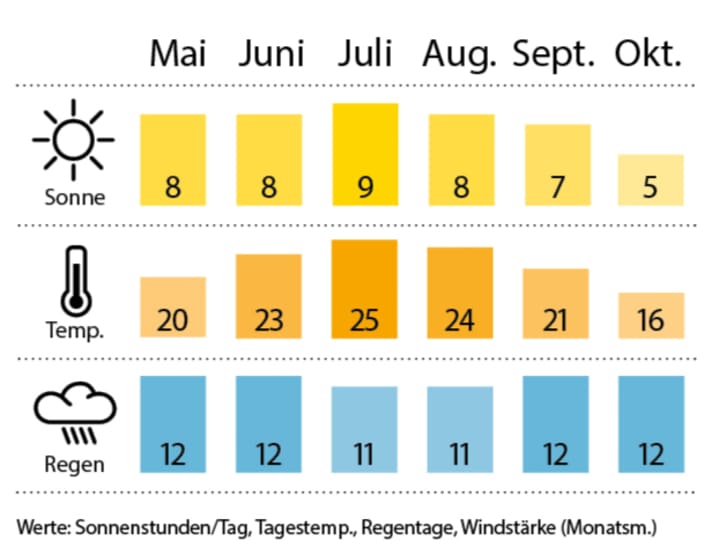





A highlight on the first evening of the trip doesn't happen often - and then in the truest sense of the word: we cross France's great river nine metres above the calmly flowing Loire. On our own keel. Because near the town of Briare, in the heart of the country, a canal bridge crosses the wide river valley. Its steel trough carries the Canal latéral à la Loire over its namesake, which is plagued by sandbanks, rapids and other vagaries. The last rivets were hammered in in 1896 and fourteen pillars have been supporting the six hundred metre long marvel ever since. For a century or so, there was nothing like it in the world.
Two ornate pillars in the Beaux-Arts style mark the approach, inspired by the decorations on the Seine bridges in Paris. We steer our charter boat across at walking pace, first over the flood meadows, then over the Loire itself. Fortunately, the dead straight route is visible from both ends along its entire length. First come, first served. We don't want to stay in Briare. So we head straight back to the other bank and into one of the bays that serve as public moorings here. We pull the fore line through a ring and hammer in a heavy peg for the stern line - and are perfectly positioned, with a fantastic view of the lower-lying landscape and later of the starry sky.
Quotes adorn the walls, large and small, even hidden, a literary quest
The fact that we are spending this evening in such an unusual place is thanks to a tip from Aurélie from Le Boat, who had picked us up at our charter base in Châtillon-sur-Loire just a few hours ago. Our week-long one-way cruise on the Loire Lateral Canal actually takes us south from Châtillon to Decize. However, Briare is in the north, but very close by: "Why don't you spend the night there tonight," she had suggested, "it's only an hour away. You shouldn't miss the trip over the pont-canal." Alors allons-y! - Let's get there then!
After a quiet night, we are woken by the bright ringing of bells on the path next to the boat. A shepherd drives his goats past. The sky is a bright blue, it's going to be a hot day. We are soon in Châtillon for the second time and drop the key to our hire car from the airport in Paris in the letterbox at the base. Aurélie will take it to Decize for us. However, our first destination is Sancerre, the centre of the only wine-growing region in the Loire during our cruise. Until then, we have around 37 kilometres of canal and five locks ahead of us. As the maximum permitted speed is only eight kilometres per hour, we will probably be travelling a little longer.
The canal runs in long, straight strokes through fields and meadows. To our left, the Loire winds through its wide valley some distance below us. We don't see much of the river, just the rows of trees that follow its banks. The canal also still has avenue-like sections. Most of them are venerable plane trees that used to provide shade on the towpath. Some of these have now been converted into cycle paths and footpaths and some have disappeared completely. From time to time, the country road accompanies us instead. Drivers honk and wave at us. The hills to the right are surprisingly flat, only rarely do you see rows of young vines. Villages and farms are inconspicuous, the windows closed by wooden shutters. But the poppies provide summery colour - and the light green water of the canal perfectly matches the wildly overgrown grassy edge above the sheet pile wall that borders its banks about half a metre high.
So, like the knights themselves, we swing into the saddle and fight our way up
In time with the many bridges, we fold down our parasol and put it up again just as quickly. The flybridge becomes a barbecue. How ironic that the two cooling towers of a nuclear power station come into view just ahead. The silhouette with the cute name Belleville - after the town nearby - will be with us for a few more hours.
We have now reached the first lock: Maimbray. Now we have to wait, because twelve o'clock has just passed - and there is a lunch break until thirteen o'clock. Further locks follow at irregular intervals: Belleville, Houards, Peseau and Bannay. Cranking is still mostly done by hand. The chamber walls are smooth or concreted, their upper edges crumbling. There are no mooring facilities in the chamber wall, so you have to rely on support "from above", where there are bollards. However, the friendly staff are always on hand. "Continuez-vous?", "Are you travelling on?" is the question at the end. "Oui!" So we are passed on to the next lock, which is already being prepared. Over the course of the day, a small convoy of three charter boats even gathers: New Zealanders in front of us, Austrians behind.
Around 5 p.m., a tall silo on the shore marks the harbour of Saint-Satur, which lies below Sancerre. We turn off to the port de plaisance, which is located in the former outer harbour of the now closed lock to the Loire. A medieval "tournament" has just finished: jousting with rowing boats. The "damsel of the castle" heaves heavy gas cylinders into her van with one hand.
Sancerre sits majestically on a hilltop. So, in the best manner of knights, we swing ourselves into the saddle and fight our way up the almost three kilometres. The subsequent stroll through the old alleyways and the panoramic view from the Rempart des Augustines completely makes up for the pedalling. By the way: some wineries offer tastings in Sancerre and pick up crews directly from the boat. Offers are displayed at the harbour. We keep an eye on the time and get a table in Saint-Satur on the terrace of the "Bord de Loire" right on the riverbank. A great menu is served for around twenty euros. We treat ourselves to a bottle of Cabernet Sauvignon from the slopes here. Like God in France? Absolutely!
An ensemble of flower-filled houses, blooming wonders and a multi-towered château
The next day, we set off without haste, slipping through the Thauvenay lock just before the lunch break. This is followed for the first time by a long stretch of forest with trees reflected in the water. We wait only briefly before we reach La Grange, where we continue on time at 1 pm. We remain alone, even at the remaining locks of La Prée and Herry, and after around 23 kilometres the warehouses of La Chapelle-Montlinard - the jetty and transhipment point of La Charité-sur-Loire - finally appear on the right bank.
We walk alongside the halte fluviale, not in the most beautiful surroundings, but at least halfway in the countryside. La Charité itself is two kilometres away, the path leads over three bridges. You realise how old the place is. Light-coloured stone and plaster shine in the sun, and the narrow Rue du Pont leads us straight to the imposing portal of Notre-Dame. Swallows dart around in a play of sharp light and shadow. The Romanesque priory church is a UNESCO World Heritage Site, a "daughter" of the famous Cluny Abbey. La Charité is still on the Way of St James. The sign of the pilgrim's shell can also be found on the bridge. The town is also dedicated to books, with small librairies to browse through everywhere. Quotes adorn the walls, large and small, even hidden, a literary quest: "Les fleurs sont des mots de l'Amour" - "The flowers are the words of love".
Around 26 kilometres and six locks are on the agenda for the following day. Again and again we pass wooded sections where the canal itself looks like a river. But shortly before Marseilles-les-Aubigny, a modern cement works towers above us, a reminder of how important the canal once was for the economy, why it was built and later expanded. The former loading pier has long been abandoned - today transport is by road and rail. The "cargo ships" that can still be seen are neglected wrecks or have been converted into houseboats - there are still a comparatively large number of both.
The inventor didn't want to give up his favourite game even in old age
After Saint-Satur and La Chapelle, we finally find a really nice mooring in a pretty park: the Port de Guétin is located in the lower outer harbour of the lock stairs that lead to the canal bridge over the Allier, a tributary of the Loire coming from the south. We have another tip from Aurélie to thank for the fact that we are staying here at half past three: one of France's most beautiful villages is located about five kilometres to the south: Apremont-sur-Allier.
The route there already leads along the old descent channel to the Allier through sun-drenched forest. This brings us unexpectedly to the Lorrains basin lock, an impressive technical monument. But it gets even better: shortly afterwards, we roll into Apremont, and its historic ensemble of flower-bedecked houses seems so perfect that you could almost imagine you were in a theme park. Even though the Parc Floral with its blooming wonders closes all too soon and the multi-towered château on the hill above the village cannot be visited, this excursion is another highlight of the trip for us. Not least because, thanks to René's perseverance, we can not only treat ourselves to a beer in the shade of the treetops on the promenade at "Les Petits Causeries", but also stretch our legs right on the riverbank again - even if it's not the Loire itself for a change.
The lower lock of the Guétin staircase has the biggest lift on this trip. Without the helpful hook, which accepts our forward line from above, it is not possible here. The stern is then held against the chamber wall with a hard rudder. And shortly after the upper chamber, we cross the Allier on the second aqueduct of the trip. Less than thirteen kilometres separate us from our penultimate destination, the city of Nevers with a population of 30,000, and the branch canal that leads to its harbour via two self-service locks. We start by sailing around in a stiff wind and then decide on a berth right next to the newly designed area by the harbour office.
This time we walk into the city, across the river and along the city wall, up to the cathedral of Saint Cyr and Sainte Julitte. It not only looks so new because its façade, complete with gargoyles and buttresses, is currently being completely restored, but also because the Royal Air Force dropped its bombs on the wrong part of Nevers in 1944 and mistakenly hit the old city centre. In front of the Ducal Palace on the open Place de la République, tents and stands are set up around a sandy playing field: the national pétanque tour is in town. In contrast to the well-known game of boules, this one-hundred-year-old variant of the sport does not require the run-up steps before the throw - which is said to be due to the fact that its ageing inventor did not want to give up his favourite game despite his stiff joints.
Eight degrees at night and lots of rain - what a contrast! So begins the last section of our journey on the Canal latéral à la Loire, another 32 kilometres and six locks. But luck stayed with us - it was going to be a really nice finish. It soon cleared up and we were spoilt by classic backcountry weather. White cloud towers wander across the blue sky and it quickly becomes summery warm again. All too soon, we reach the lock on the way down to Decize harbour. But the crew of the charter boat, which is just entering the chamber from below, need their time. Just in time for us. We make ourselves comfortable once again at the waiting area, let the last ice cubes clink and turn our faces towards the sun.
Service

Cruising stages
Distance/travelling time/locks
S Châtillon-sur-Loire - Briare: 7 km/1 h/0
- Briare - Saint-Satur (Sancerre): 33 km/7.5 h/4
- Saint-Satur - La Chapelle-Montlinard (La Charité-sur-Loire): 23 km/4 h/4
- La Chapelle - Le Guétin (Apremont-sur-Allier): 26 km/4.5 h/6
- Le Guétin - Nevers: 13 km/3.5 h/4
- Nevers - Decize: 34 km/6 h/8
ZDecize
Total: 136 km/26.5 h/26
Literature

Waterway guide: "Loire Nivernais", Volume 2 from the "Guide Fluvial" series by Éditions du Breil. Waterway charts with successive sections on a large scale, nautical and tourist information (also in German). 112 pages, many colour illustrations, format: 29.5 x 21 cm, paperback, ISBN 978-2-91312-000-6, price: € 19.50.
On the Internet
Information about the stage towns: Châtillon-sur-Loire: chatillon-sur-loire.com ▪ Briare: tourisme-briare.com ▪ Saint-Satur/Sancerre: tourisme-sancerre.com ▪ La Charité-sur-Loire: www.lacharitesurloire-tourisme.com ▪ Le Guétin/Apremont-sur-Allier: www.apremont-sur-allier.com ▪ Nevers: www.nevers-tourisme.com ▪ Decize: www.decize-confluence.fr
Weather/climate

Our boat: Horizon 1 (GRP displacement) - Length: 11.50 m - Width: 4.25 m - Berths: 4 (2 double cabins) - WC/shower: 1/1 - Special equipment: bow and stern thruster, second steering position (inside), fixed fender rails, gas grill, oven, microwave, air conditioning, large flybridge with canopy. Basic prices depending on season: from € 1670 to € 3115.
Charter: We were travelling on a boat from Le Boat's most modern series, a Horizon in the two-cabin version (above). The company also offers other boat types of different sizes and price ranges at the destination. Our one-way trip started in Châtillon-sur-Loire and ended in Decize, and the support provided by the local staff was uncomplicated and very friendly on both occasions. Le Boat has a total of four bases in Burgundy, so there is a wide range of routes to choose from. Information: Le Boat, Theodor-Heuss-Str. 53-63, Entrance. B, 61118 Bad Vilbel, tel. 06101-557 91 75. www.leboat.de
Nautical information
The channel Like the entire waterway network in France, the Loire Lateral Canal (Canal latéral à la Loire) is managed and operated by the VNF (Voies navigables de France). It was opened in 1838, but today there is almost no commercial use apart from tourism. Its route runs over 200 kilometres from Briare (connection: Canal de Briare) via Decize (connection: Canal du Nivernais) to Digoin (connection: Canal de Roanne à Digoin, Canal du Centre). www.vnf.fr
The locks The relatively low gradient of only 140 metres over the entire course of the canal is compensated for by a total of 47 locks, whereby the length of the locks varies greatly. Even though the locks are gradually being converted to electric, semi-automatic operation, most of them are still operated completely manually. The staff help with the lines, especially during upstream locks, as there are only bollards at the top of the chamber. Light signals (and other navigation signs) are an absolute exception.
The traffic Thanks to the comparatively light traffic and the calm course of the canal, the area is also suitable for beginners. A boating licence is not required. In addition to the locks, caution (and low speed) is also required on canal bridges and the sometimes very narrow bridge crossings. There are plenty of harbours and other mooring and overnight accommodation options.
The TOP 3 in the district
- The secret star is the beautiful Loire itself. It may not always be visible, but it is never far away: for a dinner with a view of the water or for sunbathing on the beach. Many a seaside resort would be delighted with this sand!
- It is no coincidence that Apremont-sur-Allier is on the list of the "most beautiful villages in France". The cycle tour from Le Guétin to the charmingly spruced-up village, crowned with a castle full of flowers, is one you won't soon forget.
- The steel trough of the Briare Canal Bridge is six hundred metres long - a world record for more than a century after its opening in 1896. There is no doubt that the passage on its own keel is a very special boating experience.

